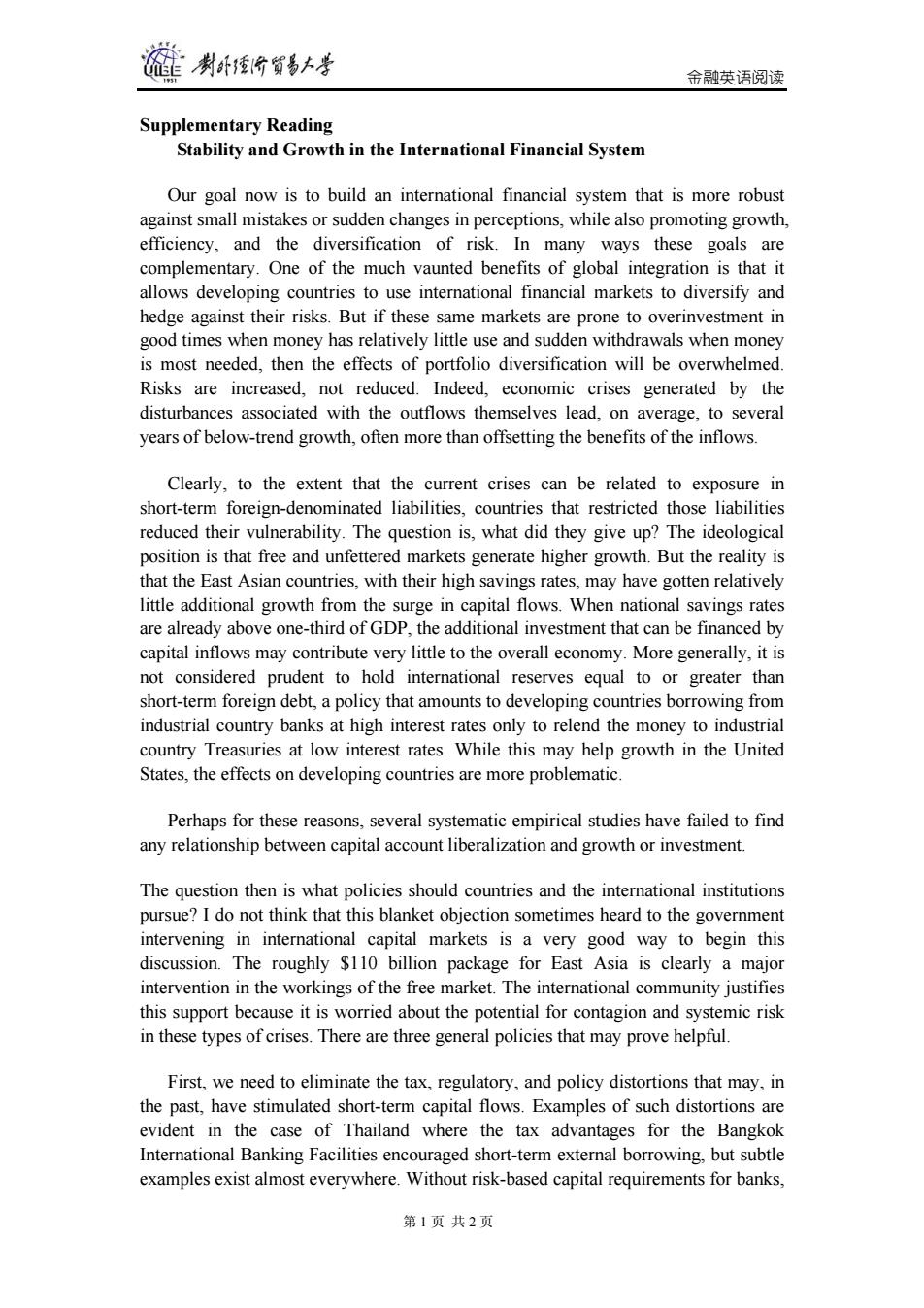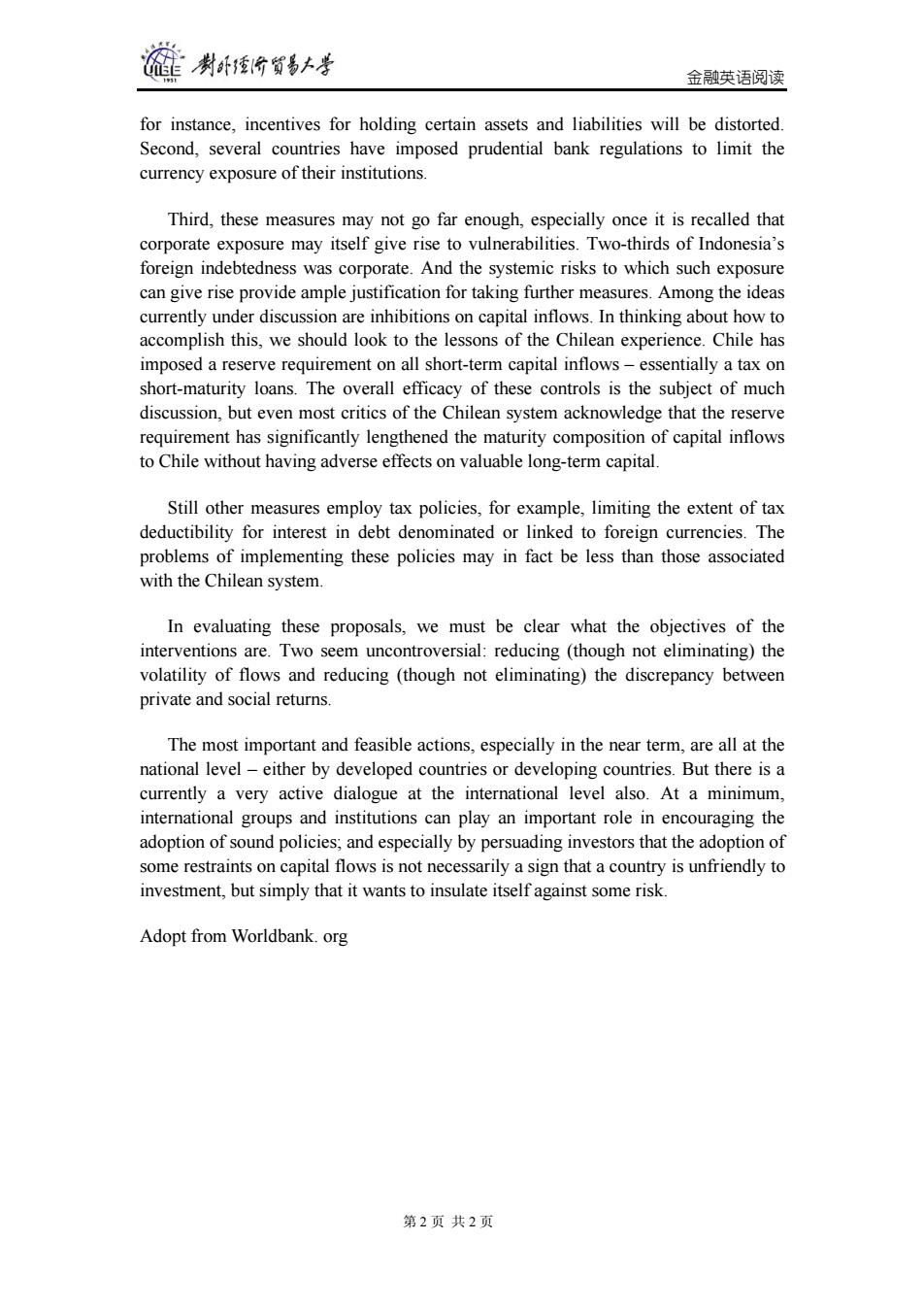
制卧爱分贸易+学 金融英语阅读 Supplementary Reading Stability and Growth in the International Financial System Our goal now is to build an international financial system that is more robust against small mistakes or sudden changes in perceptions,while also promoting growth, efficiency,and the diversification of risk.In many ways these goals are complementary.One of the much vaunted benefits of global integration is that it allows developing countries to use international financial markets to diversify and hedge against their risks.But if these same markets are prone to overinvestment in good times when money has relatively little use and sudden withdrawals when money is most needed,then the effects of portfolio diversification will be overwhelmed. Risks are increased,not reduced.Indeed,economic crises generated by the disturbances associated with the outflows themselves lead,on average,to several years of below-trend growth,often more than offsetting the benefits of the inflows. Clearly,to the extent that the current crises can be related to exposure in short-term foreign-denominated liabilities,countries that restricted those liabilities reduced their vulnerability.The question is,what did they give up?The ideological position is that free and unfettered markets generate higher growth.But the reality is that the East Asian countries,with their high savings rates,may have gotten relatively little additional growth from the surge in capital flows.When national savings rates are already above one-third of GDP,the additional investment that can be financed by capital inflows may contribute very little to the overall economy.More generally,it is not considered prudent to hold international reserves equal to or greater than short-term foreign debt,a policy that amounts to developing countries borrowing from industrial country banks at high interest rates only to relend the money to industrial country Treasuries at low interest rates.While this may help growth in the United States,the effects on developing countries are more problematic. Perhaps for these reasons,several systematic empirical studies have failed to find any relationship between capital account liberalization and growth or investment. The question then is what policies should countries and the international institutions pursue?I do not think that this blanket objection sometimes heard to the government intervening in international capital markets is a very good way to begin this discussion.The roughly $110 billion package for East Asia is clearly a major intervention in the workings of the free market.The international community justifies this support because it is worried about the potential for contagion and systemic risk in these types of crises.There are three general policies that may prove helpful First,we need to eliminate the tax,regulatory,and policy distortions that may,in the past,have stimulated short-term capital flows.Examples of such distortions are evident in the case of Thailand where the tax advantages for the Bangkok International Banking Facilities encouraged short-term external borrowing,but subtle examples exist almost everywhere.Without risk-based capital requirements for banks, 第1页共2页
金融英语阅读 Supplementary Reading Stability and Growth in the International Financial System Our goal now is to build an international financial system that is more robust against small mistakes or sudden changes in perceptions, while also promoting growth, efficiency, and the diversification of risk. In many ways these goals are complementary. One of the much vaunted benefits of global integration is that it allows developing countries to use international financial markets to diversify and hedge against their risks. But if these same markets are prone to overinvestment in good times when money has relatively little use and sudden withdrawals when money is most needed, then the effects of portfolio diversification will be overwhelmed. Risks are increased, not reduced. Indeed, economic crises generated by the disturbances associated with the outflows themselves lead, on average, to several years of below-trend growth, often more than offsetting the benefits of the inflows. Clearly, to the extent that the current crises can be related to exposure in short-term foreign-denominated liabilities, countries that restricted those liabilities reduced their vulnerability. The question is, what did they give up? The ideological position is that free and unfettered markets generate higher growth. But the reality is that the East Asian countries, with their high savings rates, may have gotten relatively little additional growth from the surge in capital flows. When national savings rates are already above one-third of GDP, the additional investment that can be financed by capital inflows may contribute very little to the overall economy. More generally, it is not considered prudent to hold international reserves equal to or greater than short-term foreign debt, a policy that amounts to developing countries borrowing from industrial country banks at high interest rates only to relend the money to industrial country Treasuries at low interest rates. While this may help growth in the United States, the effects on developing countries are more problematic. Perhaps for these reasons, several systematic empirical studies have failed to find any relationship between capital account liberalization and growth or investment. The question then is what policies should countries and the international institutions pursue? I do not think that this blanket objection sometimes heard to the government intervening in international capital markets is a very good way to begin this discussion. The roughly $110 billion package for East Asia is clearly a major intervention in the workings of the free market. The international community justifies this support because it is worried about the potential for contagion and systemic risk in these types of crises. There are three general policies that may prove helpful. First, we need to eliminate the tax, regulatory, and policy distortions that may, in the past, have stimulated short-term capital flows. Examples of such distortions are evident in the case of Thailand where the tax advantages for the Bangkok International Banking Facilities encouraged short-term external borrowing, but subtle examples exist almost everywhere. Without risk-based capital requirements for banks, 第 1 页 共 2 页

制卧台贸易上兰 金融英语阅读 for instance,incentives for holding certain assets and liabilities will be distorted. Second,several countries have imposed prudential bank regulations to limit the currency exposure of their institutions. Third,these measures may not go far enough,especially once it is recalled that corporate exposure may itself give rise to vulnerabilities.Two-thirds of Indonesia's foreign indebtedness was corporate.And the systemic risks to which such exposure can give rise provide ample justification for taking further measures.Among the ideas currently under discussion are inhibitions on capital inflows.In thinking about how to accomplish this,we should look to the lessons of the Chilean experience.Chile has imposed a reserve requirement on all short-term capital inflows-essentially a tax on short-maturity loans.The overall efficacy of these controls is the subject of much discussion,but even most critics of the Chilean system acknowledge that the reserve requirement has significantly lengthened the maturity composition of capital inflows to Chile without having adverse effects on valuable long-term capital. Still other measures employ tax policies,for example,limiting the extent of tax deductibility for interest in debt denominated or linked to foreign currencies.The problems of implementing these policies may in fact be less than those associated with the Chilean system. In evaluating these proposals,we must be clear what the objectives of the interventions are.Two seem uncontroversial:reducing (though not eliminating)the volatility of flows and reducing (though not eliminating)the discrepancy between private and social returns. The most important and feasible actions,especially in the near term,are all at the national level-either by developed countries or developing countries.But there is a currently a very active dialogue at the international level also.At a minimum, international groups and institutions can play an important role in encouraging the adoption of sound policies;and especially by persuading investors that the adoption of some restraints on capital flows is not necessarily a sign that a country is unfriendly to investment,but simply that it wants to insulate itself against some risk. Adopt from Worldbank.org 第2页共2页
金融英语阅读 for instance, incentives for holding certain assets and liabilities will be distorted. Second, several countries have imposed prudential bank regulations to limit the currency exposure of their institutions. Third, these measures may not go far enough, especially once it is recalled that corporate exposure may itself give rise to vulnerabilities. Two-thirds of Indonesia’s foreign indebtedness was corporate. And the systemic risks to which such exposure can give rise provide ample justification for taking further measures. Among the ideas currently under discussion are inhibitions on capital inflows. In thinking about how to accomplish this, we should look to the lessons of the Chilean experience. Chile has imposed a reserve requirement on all short-term capital inflows – essentially a tax on short-maturity loans. The overall efficacy of these controls is the subject of much discussion, but even most critics of the Chilean system acknowledge that the reserve requirement has significantly lengthened the maturity composition of capital inflows to Chile without having adverse effects on valuable long-term capital. Still other measures employ tax policies, for example, limiting the extent of tax deductibility for interest in debt denominated or linked to foreign currencies. The problems of implementing these policies may in fact be less than those associated with the Chilean system. In evaluating these proposals, we must be clear what the objectives of the interventions are. Two seem uncontroversial: reducing (though not eliminating) the volatility of flows and reducing (though not eliminating) the discrepancy between private and social returns. The most important and feasible actions, especially in the near term, are all at the national level – either by developed countries or developing countries. But there is a currently a very active dialogue at the international level also. At a minimum, international groups and institutions can play an important role in encouraging the adoption of sound policies; and especially by persuading investors that the adoption of some restraints on capital flows is not necessarily a sign that a country is unfriendly to investment, but simply that it wants to insulate itself against some risk. Adopt from Worldbank. org 第 2 页 共 2 页